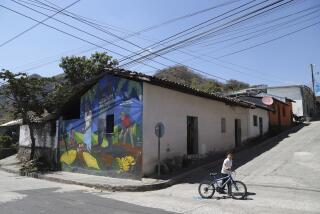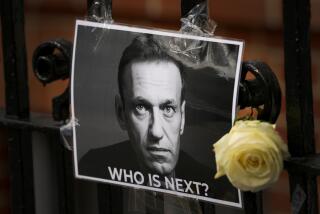Soviet Reformist Political Groups Challenge Party
- Share via
MOSCOW — A new political movement is rapidly growing across the Soviet Union, challenging the ruling Communist Party to be bolder in its reforms--or face direct competition for popular support.
In the Baltic republic of Estonia, the People’s Front of Estonia has enlisted more than 40,000 members in three months and last week drew 100,000 people to a rally demanding political, economic and cultural autonomy.
In Lithuania, another Baltic republic, the Restructuring Movement organized a similar rally of 10,000. And in the cities of Kiev, Riga, Omsk, Yaroslavl, Irkutsk and Novosibirsk, as well as in Moscow and Leningrad, political “action groups” have sprung up in the last three months, each with the purpose of promoting broader and faster reforms, either in cooperation with the Communist Party or in competition with it.
“This is democratic opposition,” Kazimiera Prunskiene, an economist and one of the organizers of the Restructuring Movement in Lithuania, said recently, explaining the group’s plans to put forward reform proposals and seek public support. “It is not a political (party), and yet it is opposition.”
Although many Communist Party officials, protecting their 70-year monopoly on power, have dismissed the groups as politically immature or simply unnecessary, a few leaders are embracing them as a way to build support for perestroika, the party’s own reform program, and to counter the opposition they are meeting from party conservatives.
Soviet leader Mikhail S. Gorbachev called on the special Communist Party conference here this week to take a close look at the movement, in the context of increasing democracy in the country and the involving of many more people in government.
“A nationwide patriotic movement in support of the party’s course of perestroika is being formed in the country,” he said. “It comprises all the forces coming out for improving the life of society--Communists, members of the League of Young Communists, non-party people, religious believers, women, veterans, youth and members of all the main civic organizations.
‘Deep-Going Processes’
“This movement reflects the deep-going processes in our present social and political life and adds to the confidence in the success of perestroika. At meetings and rallies and in the press, people have come up with various proposals on the future of this movement and on possible forms of its activity. Let us discuss this question.”
Establishment of such a front, which might draw millions of people from outside the party, would considerably broaden Gorbachev’s power base, helping him muster organized support for his reform program and making it easier to overcome conservative opposition within the party itself.
“The Communist Party, with its established structure, its bureaucratic nature and its huge apparatus, could well be supplemented by some new social formation like a Popular Front or Union for the Promotion of Perestroika,” Tatyana I. Zaslavskaya, a prominent sociologist who advises Gorbachev, suggested last month.
Special Political Status
Such a front “would have a special political status, promote coordination of like-minded people fighting for perestroika and help them in the difficult daily struggle each of them is waging in his work place or public post,” she added.
Although there are now several hundred new political discussion groups nationwide, they have remained dispersed and consequently have had limited impact so far. “The creation of . . . contacts among active supporters of perestroika could be very useful,” Zaslavskaya said, “and it would promote pluralism in our political structure.”
Call for Revitalization
Gorbachev’s call Tuesday for revitalization of local and regional councils with competitive, multi-candidate elections also could make the groups a major element in the new political structure if they nominated their own candidates and campaigned on issues largely ignored by the Communist Party.
But the party’s entrenched conservatives, accustomed to the monopoly of power since the Bolsheviks defeated their last rivals in the early 1920s, are likely to move against the action groups if they continue to outflank them.
“Our party holds the political initiative and leads the reforms,” Nikolai A. Zolotorev, deputy head of the party Central Committee’s organization department, said when questioned recently on television about the new groups. “It was the party that began perestroika and that continues to develop it profoundly in society.
“When we talk about the creation of a parallel party of supporters of perestroika, the question arises: For what aim? Our party calls them into its ranks.”
Also wary are political dissidents who see a government attempt to draw more moderate dissident groups and human rights campaigners into an official body, leaving their movement one of radicals only.
Criticized by Emigres
Emigre organizations from the Baltic republics and the Ukraine already have warned that the new popular fronts are attempts to thwart the creation of real opposition parties there.
Yet the strong official opposition encountered by some of the new organizations makes such a plot unlikely. The Moscow-based Movement for Social Initiatives, for example, has been repeatedly attacked in the official press as “anti-Soviet,” “anarchist” and “extremist.” In Leningrad, party officials have tried to prevent similar groups from meeting.
One leading proponent, Boris Kurashvili, a researcher at the influential State and Law Institute, has been urging the establishment of a new organization with a national headquarters and local branches.
“We still have no mass-participation public formations that unite the wide range of social initiatives of those people who are not members of the Communist Party and who, after all, make up the majority of the country’s population,” he said in an article that helped lay the foundation for the People’s Front of Estonia.
Kurashvili, campaigning in liberal newspapers, has said the organization should have the right to criticize party and government policies, to publish its views in the press without censorship, to participate in election campaigns and to sponsor legislative initiatives.
Despite such political activities, Kurashvili, Zaslavskaya and other proponents of a national front say that it would not become another party.
‘Functions of a 2nd Party’
“We have no real social-class basis for a second party,” Kurashvili said, “but nevertheless there is a need for an organization that could perform some of the functions of a second party.”
The closest model to what Gorbachev and his advisers may have in mind is the umbrella group formed in Hungary outside the Hungarian Socialist Workers Party to push for reform. Its leader, Imre Pozsgay, was elected to the party’s ruling Politburo in Budapest last month.
More to Read
Sign up for Essential California
The most important California stories and recommendations in your inbox every morning.
You may occasionally receive promotional content from the Los Angeles Times.










